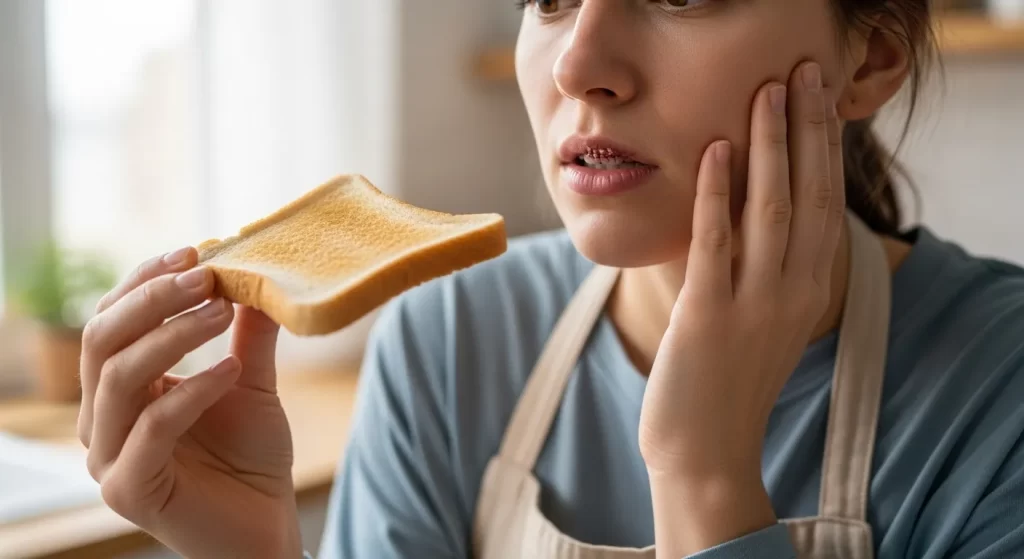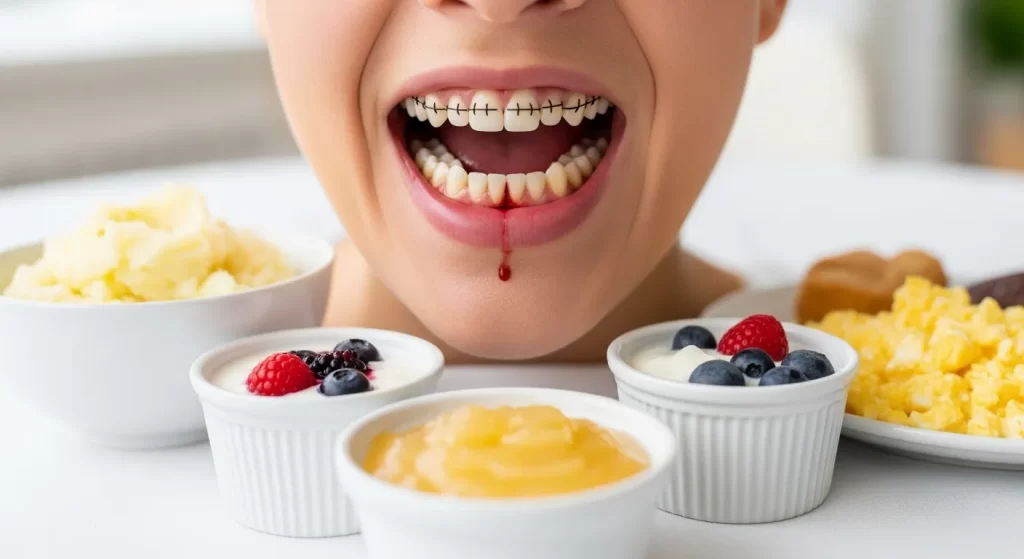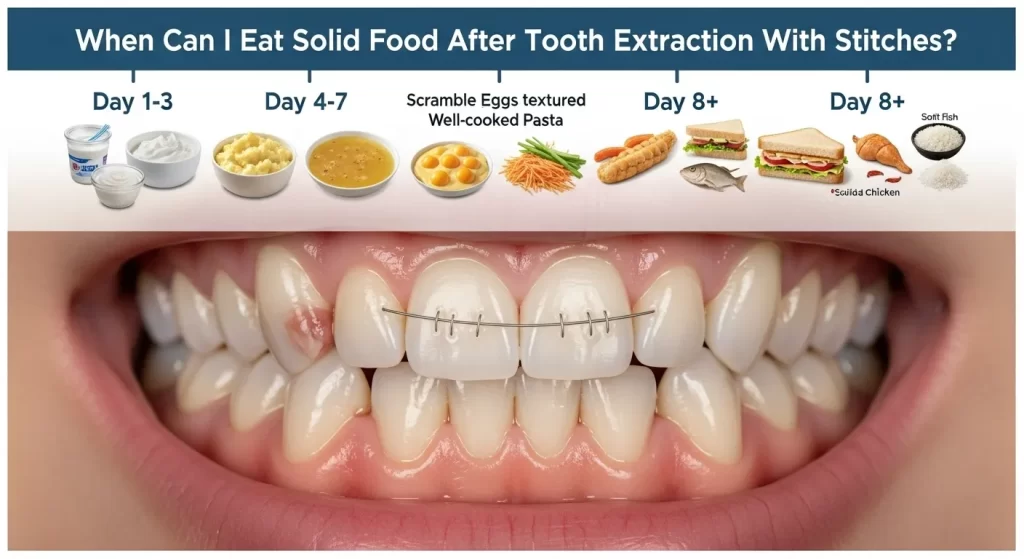Table of Contents
I know how confusing it feels after a tooth extraction, especially when stitches are involved. Many people wonder, “When can I eat solid food again?” That question is more common than you think, and it’s the key to making recovery smooth and safe.
We often rush back to regular meals, but your mouth needs time to heal. The blood clot forming in the socket is fragile, and disturbing it too soon can cause pain or complications like dry socket. That’s why following a clear timeline is important for eating after extraction.
Why Healing Time Matters

They tell us to be careful after dental surgery for a reason. Healing isn’t just about comfort it’s about protecting the blood clot that seals the wound.
This clot shields your nerves and bone, and it takes about 3–5 days to stabilize. If it gets disturbed, you could face delays in healing, infection, or even weeks of pain.
What the First 24 Hours Look Like
I remember being surprised by how strict the first day’s instructions were. Dentists say:
- Do not eat solid foods at all.
- Stick to cool or lukewarm soft or liquid foods.
- Avoid straws since suction can pull out the clot.
Some safe choices include:
- Yogurt or pudding
- Mashed potatoes
- Smoothies (with a spoon)
- Broths and soups that aren’t too hot
It might feel limiting, but these foods soothe the wound and give your body time to start healing.
Moving Into Day 2 and 3
We usually start feeling a little better by the second or third day. That’s when it’s possible to introduce foods with a bit more texture but still soft enough to swallow without chewing hard.
Some good examples are:
- Scrambled eggs
- Mashed avocado
- Cream of wheat or oatmeal
- Soft fruits like bananas
- Cooked, well-softened vegetables
At this stage, gentle rinsing with warm saltwater helps keep the area clean. Just remember to tilt your head instead of swishing hard.
Days 4 Through 7: A Turning Point
By this point, many of us feel more confident. The swelling often goes down, and bleeding should stop. But even if you feel okay, it’s still not time for crunchy or sticky foods.
Instead, choose foods that are:
- Fork-tender and soft
- Easy to chew on the opposite side of your mouth
Good options include:
- Overcooked pasta or rice
- Flaky fish like salmon
- Shredded chicken that’s very tender
- Steamed vegetables, softened completely
Think of this week as a “transition zone” your meals look more normal, but chewing remains careful and limited.
The One-Week Mark and Beyond
We often hear people ask, “Can I go back to normal food now?” Around 7 to 10 days, many patients with simple extractions can resume regular meals.
For more complex cases like wisdom teeth removal, the timeline is often 10–14 days or more. About 5 million wisdom teeth are removed every year, so if you’re in this group, know you’re not alone in waiting longer to chew normally.
At this stage, dentists usually check the stitches and healing progress. If everything looks good, you can slowly reintroduce more solid foods just avoid crunchy snacks, hard bread, or sticky candies for a bit longer.
Foods That Make Recovery Easier

I find it helpful to keep a list of safe foods on hand during recovery. Here’s a quick guide:
- Soups and broths (lukewarm, no chunks)
- Mashed potatoes or yams with butter or gravy
- Yogurt (plain, protein-rich)
- Applesauce
- Scrambled eggs
- Smoothies (no seeds, eaten with a spoon)
- Cottage cheese
- Ripe avocado
- Soft oatmeal
- Tender chicken or fish when chewing isn’t painful
- Steamed, soft vegetables
These foods give comfort and nutrition without risking the healing area.
What to Avoid for Safety
They warn us strongly about what not to eat or drink. Ignoring this list can cause setbacks.
- Hard, crunchy foods: chips, nuts, popcorn, granola
- Sticky foods: caramel, gum, dried fruit
- Spicy foods: hot sauces, curries
- Acidic foods: tomatoes, pineapple, vinegar-heavy meals
- Hot beverages: coffee, tea, very hot soup
- Dairy in the first day or two (can upset sensitive tissues)
- Alcohol or carbonated drinks
- Straws, smoking, or vigorous rinsing
These things can irritate the wound, dissolve the clot, or delay healing.
Nutrients That Speed Recovery
We often overlook how nutrition helps the body repair itself. Eating foods rich in vitamins and minerals makes healing faster.
- Protein: eggs, yogurt, cottage cheese, soft meats
- Vitamin A: sweet potatoes, leafy greens
- Vitamin C: soft fruits, citrus (but avoid acidity early on)
- Vitamin E & B12: nuts, seeds, fortified foods
- Zinc: avocado, cottage cheese, nut blends
Balanced meals give your tissues what they need to rebuild and close the wound properly.
Signs That Something’s Wrong
Sometimes, even when we follow instructions, problems happen. If you notice any of these, call your dentist right away:
- Severe or worsening pain after day 3
- Persistent bleeding
- Bad taste or odor from the wound
- Visible bone in the socket
- Swelling that doesn’t improve
These could signal dry socket or infection. The sooner you act, the quicker treatment works.
Tips That Make Healing Easier

I’ve found small daily habits make a big difference during recovery. Here are some simple practices:
- Drink plenty of water.
- Rest with your head elevated to reduce swelling.
- Apply cold compresses in the first 48 hours.
- Avoid heavy lifting or workouts for a few days.
- Chew on the opposite side of the mouth.
These steps protect your clot and help your stitches hold in place.
The Role of Follow-Up Visits
We sometimes forget that follow-up appointments are not just a formality. They allow your dentist to check healing, remove stitches if needed, and confirm when solid food is safe.
Places like Willoughby Dental, Montgomery Family Dental, Springhill Dental Center, and Midland Dental all stress the importance of staying in touch if you have concerns. Don’t hesitate to call your local provider if anything feels off.
Final Thoughts
I know the waiting feels long, but patience pays off when healing from tooth extraction with stitches. Most people return to normal meals after a week, while others, especially wisdom tooth patients, may need up to two weeks or more.
The key is listening to your body, sticking to soft foods early, and avoiding anything that risks the clot. With care and good nutrition, recovery goes smoothly, and solid food becomes enjoyable again without pain or setbacks.
So the next time you ask yourself, “When can I eat solid food after tooth extraction with stitches?”, remember: slow and steady truly wins this race.
FAQs
1. When can I eat solid food after tooth extraction with stitches?
Most people return to solids in 7–10 days. Wisdom teeth may need 10–14 days or longer.
2. What can I eat the first day after extraction?
Stick to soft foods like yogurt, pudding, mashed potatoes, smoothies, or broth. Avoid hot, crunchy, or chewy items.
3. Can I drink coffee after tooth extraction?
Avoid hot coffee for the first 24–48 hours. Lukewarm or iced coffee is safer after the clot forms.
4. How do I prevent dry socket?
Do not use straws, avoid smoking, eat soft foods, and follow your dentist’s aftercare instructions.
References
- American Dental Association (ADA). Tooth Extraction Aftercare Guidelines. Available at: https://www.ada.org
- Mayo Clinic. Wisdom tooth removal: Recovery and Aftercare. Available at: https://www.mayoclinic.org
- Cleveland Clinic. Tooth Extraction: What You Need to Know. Available at: https://my.clevelandclinic.org
- Colgate Oral Care Center. What to Eat After Tooth Extraction. Available at: https://www.colgate.com
- Healthline. What to Eat After Getting Your Wisdom Teeth Out. Available at: https://www.healthline.com
- National Institutes of Health (NIH). Nutrients for Wound Healing. Available at: https://www.nih.gov
- Willoughby Dental. Post-Extraction Care. Available at: https://www.willoughbydental.com
- Montgomery Family Dental (Marysville). Call: (937) 240-5153.
- Springhill Dental Center, AL (Dr. Byron Scott). Contact online: https://www.springhilldentalcenter.com
- Midland Dental. Consultation for Oral Surgery Recovery. Available at: https://www.midlanddental.com
Disclaimer: This content is for informational purposes only and not medical advice. Always follow your dentist’s instructions for care.
Author
Eric Davis is a dental health writer and oral care expert with years of experience explaining recovery tips in simple, human-focused language. He helps patients feel confident about healing after procedures.




